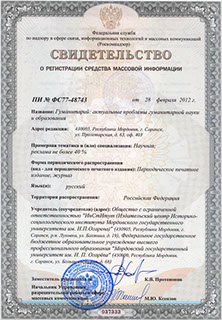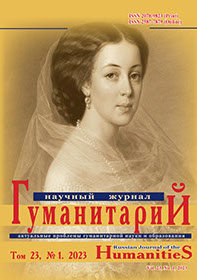ГуманитариЙ актуальные проблемы гуманитарной науки и образования
Russian Journal of the Humanities
ISSN 2078-9823 (Print)
ISSN 2587-7879 (Online)
Navigation
ISSN 2078-9823 (Print), ISSN 2587-7879 (Online)
DOI: 10.15507/2078-9823.061.023.202301.033-047
Anna N. Zankina
Mordovia Republican United Museum of Local Lore named after Ivan Dmitrievich Voronin (Saransk, Russia),
e-mail: raksha2008@rambler.ru
Activities of Club Institutions in the Soviet Period (by the Example of the Tatar Locality of Mordovia)
Abstract
Introduction. The events of the October Revolution of 1917 completely changed all aspects of public life. This change occurred, among other things, due to large-scale public education. The purpose of enlightenment was the formation and popularization among the citizens of the country of a new proletarian culture based on Marxist-Leninist ideology. The spread of club institutions helped to achieve this goal. The purpose of the article is to analyze the activities of club institutions in the Tatar locality of Mordovia during the Soviet period. The article contains statistics on the number of club institutions and their variety, talks about the difficulties that club institutions faced, and so on.
Materials and Methods. The research is based on documents from the Central State Archive of the Republic of Mordovia. Previously published studies that talk about Soviet educational policy have also become an important source. The methodological body of the study includes comparative-historical, chronological and statistical methods.
Results. During the study, statistics were prepared on the number and types of club institutions in the Tatar locality of Mordovia, and some of their features have been identified. Problems faced by club establishments have been identified. The main problems were material difficulties, the lack of proper attention to club institutions by local authorities, and the lack of qualified personnel.
Discussion and Conclusion. The study of this topic made it possible to establish that the Tatars living in Mordovia, together with the Russian and Mordovian people, became part of the general cultural and educational process that began after 1917. In the Tatar locality, various club institutions developed, which, in the case of good personnel work and a responsible attitude on the part of local authorities, became a real cultural center and carried out large-scale political and educational work. The article also provides examples of the unsatisfactory work of club institutions. For example, they did not function in every Tatar locality. Often, one club could unite several settlements, and this situation was observed throughout Mordovia.
Keywords: Mordovian Autonomous Soviet Socialist Republic, Tatars, culture, cultural and educational activities, club institution, club, reading room, house of culture.
For citation: Zankina А. N. Activities of club institutions in the Soviet period (by the example of the Tatar locality of Mordovia). Gumanitarian: aktual’nye problemy gumanitarnoi nauki i obrazovaniia = Russian Journal of the Humanities. 2023; 23(1): 33–47. (In Russ.). DOI: 10.15507/2078-9823.061.023.202301.033-047.

© Ogarev Mordovia State University. History and Sociology Institute, 2017
68, Of. 411, Bolshevistskaya St., 430005, The editorial office of the scholarly journal «Russian Journal of the Humanities»
Tel.: (8342) 24-25-90; 27-07-11, Fax: (8342) 24-25-90, E-mail: jurnal-econom-hist@isi.mrsu.ru
Designed by A. Napalkov, Email: napalkov@isi.mrsu.ru

